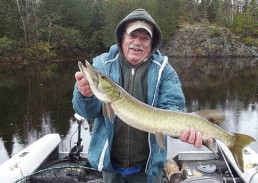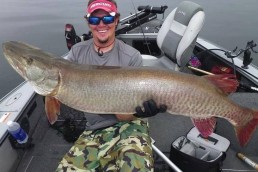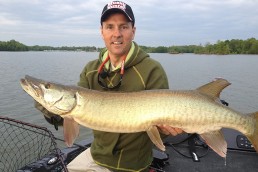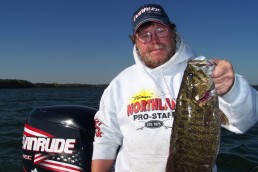Early U.P. Muskies: Find ‘em, Catch ‘em
SHARE THIS POST
The courageous and rapid growth cycle from vulnerable egg to voracious predator truly enhances the muskie’s list of admirable traits. However, beauty is in the eyes of the beholder. Salmon, for example, have a very courageous and unique lifestyle as do many species. As hunters and anglers, we respect our favorite prey and the unique features that make them tick. So, let’s review what we already know, what we don’t know, and what we may have forgotten about the life cycle of muskies; then, let’s learn how to apply that knowledge to ensure successful days on the water.
The life and life cycles of Esox masquinongy begin in spring and, for our purposes, are divided into the following: 1) The spring spawning period; 2) hatching; and 3) growth.
1. The spring spawning period
The muskellunge spawn shortly after the ice has melted, but later than the northern pike, usually in mid-April to late May, but more importantly, when the water temperature is 49 to 59 degrees F. The optimum or prime temperature is 55 degrees F. (More about temperature later).
A large female is usually accompanied by a smaller male (sometimes two males). The pair swims in water as shallow as 15 to 20 inches over heavily vegetated areas, flooded areas, or shallow bays with muck bottoms covered by dead vegetation. Swimming side by side over these areas for several hundred yards, the fish roll at various intervals so that the anus of the male and the female are close together. A small number of eggs and sperm (milt) are shed simultaneously during rapid shaking of the bodies. The lashing of the tails of the two fish spreads the fertilized eggs and the pair swims on. These rapid gyrations of the male and female are enacted many times at various intervals over several days.
No nest is built; the semidemersal, apparently nonadhesive eggs are randomly scattered and fall into the vegetation. This entire spawning process normally lasts no more than a week’s time, with the females laying between 22,000 and 180,000 eggs. The number of eggs is usually determined by the size of the female. Larger females produce the greatest numbers of larger eggs.
When the spawning process is over, the adults leave the area, providing no parental care. Muskellunge come back to the same areas each year to spawn.
2. Hatching
Hatching occurs in eight to 14 days at water temperatures between 53 and 63 degrees F. Generally, only 34 percent of naturally spawned eggs are fertile, whereas, in a hatchery, the fertility rate can be as high as 95 percent.
When hatching, the young are 9.5 to 10.3 millimeters in length and may, in the natural environment, remain dormant in the vegetation for approximately 10 days or until the yoke is consumed. Then, they become active, and voracious feeding begins. The fry (young fish) begin feeding on zooplankton (microscopic aquatic animals). This diet continues for one to three weeks, and the young fish then move on to some small plankton and small fishes. Usually, when they attain a length of 1.5 inches, the diet is switched to fish alone.
3. Growth
Growth in the first season is, to me, remarkably rapid. By 10 weeks of age, they are approximately six inches in length. By November of the first year, they are almost double that size, from 10 to 12 inches in length. Growth is most rapid in the first few years, but slows in length as sexual maturity occurs. Males reach maturity in four to five years, when they are 28 to 31 inches long; females mature at five to seven years, when they are from 30 to 36 inches in length. Of particular interest to anglers, though, is the fact that an increase in weight continues virtually into old age.
How long do muskellunge live? Most muskies live to be, on average, about eight years old. However, some fish have been caught and recorded to have lived to be 18 and 19 years old.
Many veteran muskie anglers are already aware that most of the larger, record-sized muskies are females, but do you know why? It is because there is remarkable sexual dimorphism in growth. The muskie world is a woman’s world: females grow faster than males, are larger at any age, and live longer. Face the facts, female muskies control their environment!
They are most comfortable in temperatures ranging from 33 to 78 degrees F. However, this species can withstand water temperatures as high as 90 degrees F for short periods. Look in the “slop” starting from June into August.
What and how do muskies eat?
You all know that kids are curious, and when they ask me what muskies eat, I usually answer, “Anything they want,” which isn’t far from the truth. Getting more specific, however, muskies in the fry stage and larger will eat a wide variety of fishes. A publication by the Wisconsin DNR Bureau of Fisheries reports: “As soon as a fish (any species will do, from gamefish to minnows to other muskellunge, with suckers and perch particular favorites) swims into view, the muskellunge strikes, impaling the prey sideways on its large canines, then rotating the fish and swallowing it head first.” Bass, rock bass, sunfish like bluegills and crappies, and bullheads, to name a few, are all fair game. Attacking any large spiny-rayed fish sideways helps to collapse these spiny rays before engulfing the food.
Finally, there appears to be a direct correlation between the size of a muskie and the size of food (mostly fish) that they select. It seems that adequate size of prey rather than vast numbers of smaller prey may be more important to the growth and survival of larger muskies. Now there’s some food for thought. Perhaps bigger baits are the way to go, even in May through August.
Research and common sense equals best hot spots to start
Is your favorite lake self-sustaining—that is, does natural reproduction occur? If you know where the muskie spawning grounds are, the muskies could be in close proximity. Remember, we said that muskellunge return to the same areas each year to spawn. Check with the locals on your favorite lake or ask your DNR biologist.
Are you enjoying this post?
You can be among the first to get the latest info on where to go, what to use and how to use it!
By the end of May in the upper Midwest, for example, the muskies should have completed the actual spawning cycle and moved to the post-spawn cycle. The cycles, however, are controlled by water temperature and day length. So, where should you begin your muskie search?
Look for water that is warmer than 50 or 60 degrees, the temperature that muskies prefer to spawn in. Then, search those areas.
Secondly, most avid muskie fishermen I know will fish smaller lakes in the early season because they warm faster. More importantly, these lakes will pass through the spawning cycle first and will give you better action sooner.
Third, because the southerly cycle of the sun warms the north end of a lake sooner, opening-day fishermen would do well to fish that end, especially the shallow areas.
Lastly, fish rivers during the early season because they warm faster than lakes. These muskies go nuts in June, but you want more specific spots, so here are a few of Dock’s picks.
U.P. muskie hot spots:
Central U.P. (includes Iron Co.,my home lakes)
Lake Emily – Here is a numbers lake, under 500 acres and weedy. Brown is the best lure color, along with chartreuse. Some high 40s are available.
Chicagon Lake – 1,100 acres of gin-clear water. For best results, fish low-light hours and cloudy days. Troll Believers and throw silver and black bucktails, and other lures, like sliders.
Stanley Lake – I lived on it for eight years. Fish the tops of the cribs (get a map) and troll until dark and beyond in the trough in front of the 4 Seasons Resort (15 to 30 feet).
Paint Pond – This is on the Paint River system. Fish it at the dam in Crystal Falls, too. Try bright lures including Suicks and Bulldogs.
Western U.P.
Lac Vieux Desert – This border lake is shallow and weedy and has some big lunkers. Work the weeds with bright bucktails and weedless spinnerbaits. Fish the islands and get a map (it is 4,000 acres).
Cisco Lakes Chain – This chain in Gogebic County is not fished much for muskies. Especially productive is Cisco Lake and Thousand Island Lake. Troll to get the lay of the water and then fish the humps and shorelines where weeds are present. Ciscos are present, so big, 50-inch fish are present.
Eastern U.P.
Taquamenom River – In Luce County, this is an excellent June spot for numbers of muskies. Try small bucktails first.
St. Mary’s River, Muniscong Bay – It is a shallow, weedy, green-stained bay that averages about three feet deep. It has big Great Lakes muskies and should be up shallow after spawning. Troll the edges of the main channel.
Have fun in Michigan’s waters of “Ahhhs!”
MWO
SHARE THIS POST
Did you enjoy this post?
You can be among the first to get the latest info on where to go, what to use and how to use it!
Robert Dock Stupp
MidWest Outdoors works with more than 200 outdoor experts each year, who contribute articles based on their areas of expertise. MidWest Outdoors magazine offers more fishing and hunting articles than any other publication!



